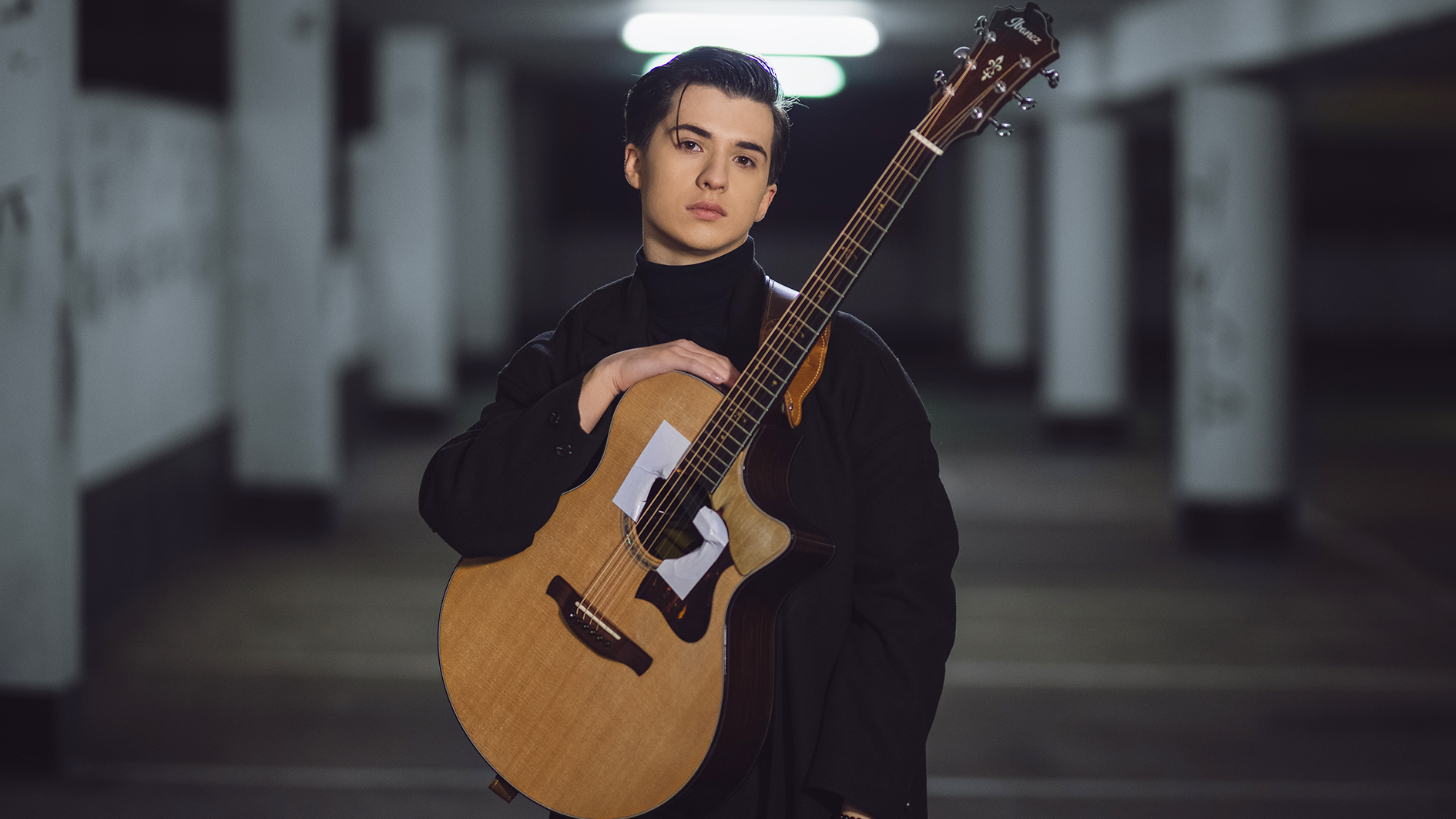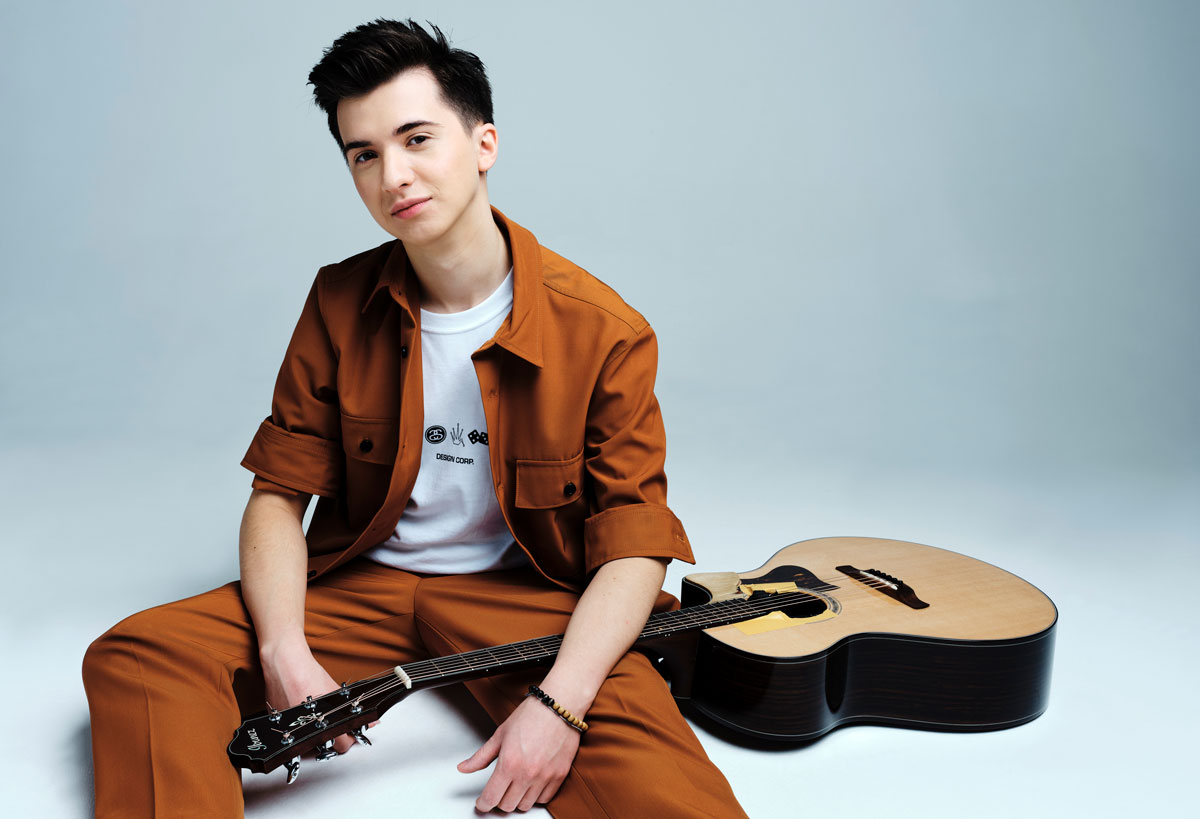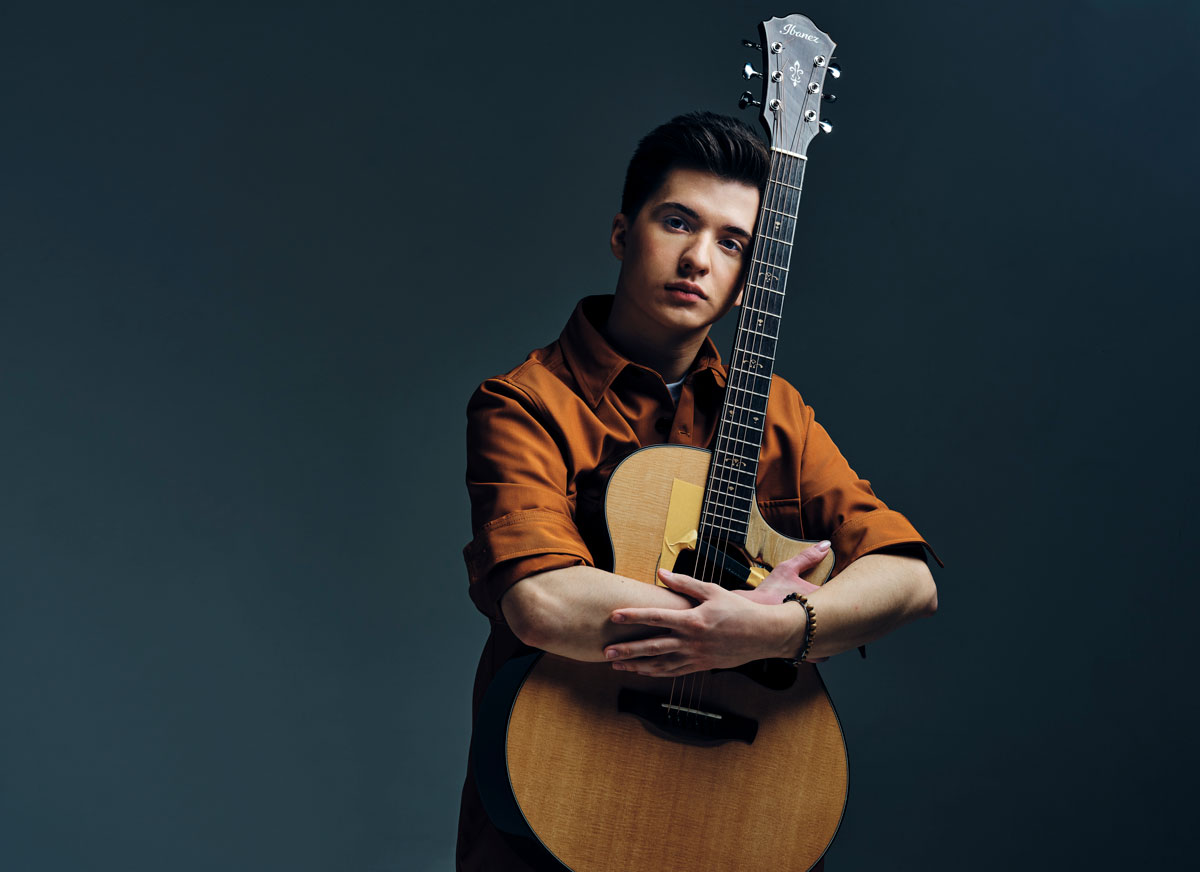Marcin Patrzalek: “My goal is to show the world that percussive acoustic guitar should be the next big thing”
Following his knockout viral cover of Led Zeppelin's Kashmir, the Polish fingerstyle wunderkind dives deep on his mesmerizing technique, melding genres and why he got bored of playing classical music

It certainly feels like the world of percussive fingerstyle acoustic has never been more vibrant than it is right now – with last year’s return of British virtuoso Jon Gomm and Mike Dawes’ viral tribute to Eddie Van Halen with his solo arrangement of Jump, fretted and drummed on his striped-up Andreas Cuntz signature.
As for rising stars, 20 year-old Polish guitarist Marcin Patrzalek could very well be one of the most exciting names to have emerged in recent years, having won competitions in his native country before appearing on 2019’s America’s Got Talent, eventually getting through to the semi-finals.
His YouTube videos have each racked up millions of views, perhaps most notably his wild reinventions of Moonlight Sonata and Beethoven’s Symphony No 5, which he famously spliced with System of a Down’s Toxicity in front of Simon Cowell and his co-judges on primetime television...
“My goal is to show the world – not only musicians and guitarists – that percussive acoustic should be the next big thing,” says Patrzalek, talking to GW from his home studio.
“It deserves attention from the mainstream and the average Joe, because it’s something many still haven’t seen or heard. That’s why my own songs, like Snow Monkey, are more mainstream-oriented, with hip-hop, Latino and Reggaeton influences. It’s a marriage between experimental playing and very much mainstream and accessible things...
“I’m not saying my next album will sound like Ariana Grande, but I’m always trying to push where it can go. Maybe at times that’s something that’s lacking in the guitar world. I love experimental and niche music, but I want everyone to know that you can put percussive guitar into anything you want. Using these different sounds and approaches will help the general public understand this will be the next big thing!”
His latest clip, which sees him tackling Led Zeppelin classic Kashmir, racked up 700k views in its first week – and deservedly so, when you factor in the mind-boggling musicianship and sheer inventiveness with the Ibanez in his hands.
Get The Pick Newsletter
All the latest guitar news, interviews, lessons, reviews, deals and more, direct to your inbox!
Here, he talks GW through his early roots, dazzling techniques and the secrets to getting the most out of his six-string...
When was the moment you realized the acoustic would be your primary means of expression?
“I picked up the guitar when I was 10. It was a classical guitar and in that kind of world, 10 is actually kinda old to be starting. When you see these classically trained violin players, they usually start at four or five. I got into playing classical because my dad wanted to find me something to do. I didn’t ask him though…
“I loved music, especially metal around the age of 10. Metallica is usually the first thing people get into with heavy metal. My dad is also really into rock, so he wanted me to start practicing. His friend was a classical teacher and they randomly bumped into him in a shop, and that guy told him he wouldn’t teach me because he hated children...”
That’s quite an odd thing to say…
“What a response, right?! But he gave my dad the card of a different teacher in the same city, and that guy did take me on for lessons. Immediately he was impressed and very supportive. So I started out playing purely classical and started gaining some recognition in terms of contests here in Poland.
I slowly started to get a little bored of classical music – or rather just repeating what others had played for decades, for centuries
“I really enjoyed practicing, which is something people don’t normally like, and that helped me get into it quickly. I don’t remember the exact date but my dad and my teacher have told me I won my first competition within three months… which is super quick for a beginner. It was a 10 year-old’s competition – after that I felt really motivated.”
So what did you end up doing next?
“The next few years were development-heavy for me, but I slowly started to get a little bored of classical music – or rather just repeating what others had played for decades, for centuries. You get a track to learn, it’s a standard in the classical repertoire, and you play it exactly the same way as 50 other people in your school would. So what’s the point?
“I moved on to flamenco and met a Spanish guitarist called Carlos Piñana who was over here doing workshops. And he was impressed with what I was doing, which was flattering and proposed we have classes through Skype. It was a huge deal because he was a professor at a university as well as a touring musician...
“To be taught by him as a 13 year-old was an honor! I did that for about four years and it was after getting to a good level at both genres, I got an acoustic for Christmas. That was a great Christmas gift from my parents. That’s when everything changed.”

Did you find flamenco less limiting than classical?
“Classical guitar is very traditional, there’s not much to say, but a lot of it forms the very basis of music in general, as well as guitar playing. Flamenco is less strict, but there are still these rigid rhythms and compasses, as well as a specific idea of what flamenco music is on guitar. With the acoustic guitar, there is no limit.
“You can play it around a bonfire, which is what most laymen imagine acoustic guitar is, or you can do wild stuff that nobody expects. After switching to that, it took me about a year of looking at what other percussive players were doing online and incorporating my own classical and flamenco techniques to know I could take my music even further.”
Which players have been most influential on your two-handed approach?
“I didn’t know about Michael Hedges when I started but everybody in this style eventually discovers him. He’s the OG of this style. In the '80s/'90s he essentially made the blueprints of what’s happening now and is still being developed. He died tragically and way too soon.
“I didn’t take anything from him directly but indirectly he inspired me greatly. People who cover my arrangements or play in my style will indirectly have him as an influence. His techniques transcend through everybody and I just wanted to mention him because a lot of people still don’t really know about him.”
I never really had one guitarist that was the huge idol for me, whose footsteps I wanted to tread. That was never a thing for me
“Mike Dawes is another player I look up to. When I was 15, he was starting to blow up with his arrangements and ended up being a huge influence on my style, helping me realize what could be possible.
“He’s now my friend and we keep in touch on Instagram. We had an opportunity to meet up but Covid completely destroyed that. He’s a great guy and I’m happy to know him.
“Jon Gomm is also a fantastic person and musician, we’ve talked a lot. He’s not a huge influence on my style per se; I think we’re a bit different. Also he’s a singer too, which is a fantastic thing but I don’t have any aspirations to try myself. All of these people had some influence on me – I’ll take anything from metal to flamenco to hip-hop in my arrangements.”
Which is the secret to making a lot of classical ideas feel contemporary?
“Yes, it’s what’s most important to me... taking ideas from other music styles, like when I listen to metal stuff, for example, I hear those breakdowns in djent and feel inspired. That all goes into my approach, perhaps in ways it might not for others. And the same goes for flamenco, Paco de Lucía is one of my biggest idols. You can hear so many fiery techniques and incredible things in his music.
“These are things that I borrow, which aren’t necessarily borrowed by other percussive players… everyone does their own thing. Tommy Emmanuel is another one, he had these videos that I’d watch every day when I was younger, sometimes even two a day. I never really had one guitarist that was the huge idol for me, whose footsteps I wanted to tread. That was never a thing for me.”
As you mentioned, metal and classical have a lot in common... Yngwie Malmsteen would say the same!
“In my opinion, all genres can work together. I don’t even think the word genre shouldn’t really exist – sure, it’s good for categories. But there’s no actual division. Right now I’m working on my single and my label asked me what genre I should pick for Spotify and Apple Music. Nobody really has a clue… because what does it really mean?
“A lot of metal borrows from classical and symphonic music. Yngwie Malmsteen was the go-to for that, because he learned a lot of things from Paganini and was able to combine them naturally. The techniques and harmonic structure of heavy metal can be very close to classical, especially when you look at Paganini.
“Even with a band like Animals As Leaders, who incorporate a lot of jazz ideas, there are so many harmonic similarities. If they didn’t use distortion or heavier drum beats, maybe it would be more obvious.
“Then there are bands like Chon, but if you take away the drumming and rhythms, you would be very close to jazz and classical music. It all comes down to which steps you take and how you branch out...”
I try to make everything sound different, even if it’s a one minute video on my Instagram. I like to digress into all sorts of things… that’s the cool thing about today’s music, there’s really no boundaries
And you have a major label helping you do that, which is interesting...
“Sony, who I am working with, have a good budget for what I can do, so I’ve been embracing more electronic stuff. If you look at Moonlight Sonata, which is the biggest video on my YouTube channel and obviously a classical arrangement, there’s some big bass underneath it and 808s in one section – which has more of a hip-hop sound. There’s also clapping which is more of a flamenco-inspired thing.
“It’s a marriage of genres, like a lot of pop music. Ariana Grande is nearly rapping nowadays. Polyphia are making trap-inspired metal. Things are going in different directions.
“What I’m not a fan of, if I can go on a tiny tangent, is when people arrange things and that’s all they do. It’s a good way of revisiting things, but when you arrange it for percussive fingerstyle, why not try to experiment a bit?
“I try to make everything sound different, even if it’s a one minute video on my Instagram. I like to digress into all sorts of things… that’s the cool thing about today’s music, there’s really no boundaries.”
You’ve been working with Ibanez guitars for a while now...
“And they have been a blast to work with. They’re such amazing people and it’s clear they see the potential of percussive playing and where it can go in the future. They want to invest into that, which is something not many brands want to do these days. The one I’m playing right now is the AE900. I’m not sure if it’s still produced, it’s become a bit of niche thing, but they have many similar models in the AE line-up.”
What do you like about how they play?
“The main thing about these guitars is that they’re strong – you can really hit them and not worry about anything breaking. The action is also pretty good immediately, but also very easy to adjust. I play with a very low action so it’s easy to play certain things and there’s no buzz.
“Despite being a very commercial manufacturer, the instruments are still very high quality. I see a lot of younger players picking up the acoustic because of me, which is very flattering, and it’s great because they can all afford an Ibanez. If I was playing a $20k guitar, there’s no way people could get the same instrument.
“It’s a very organic guitar – just an acoustic with a scratch pad that I attach myself. They’re a very accessible brand and very good to work with. I’m actually working on a special project with them that will get announced in the future.”
And where does your guitar go next?
“When I play live I prefer to go DI. I don’t do amps because this style is very delicate with a lot of dynamics. The pickups I use are Fishman and like Ibanez they see the full potential of percussive playing.
Every player should see what their strengths are, and we all have unique talents
“I use the same ones that Jon Gomm uses, and they’re able to pick up the whole body. For the AGT semi-final, I went fully drive with no pedals, no thing… which was very weird.
“Compression is very important because I’m always tapping or playing percussion. You want to get all the volume you can, but obviously not too much. EQ is very important too – I know most players think of delays or distortions or reverbs when it comes to pedals but in this style you need to focus on the technical side.
“It’s all about EQ, compression, ambient reverbs… things that will make your instrument sound huge. Like an orchestra, not like just one guitar.”
As for the technique aspect of modern fingerstyle, were there any exercises that were fundamental in your development?
“In this style, left-handed tapping is by far the most important because if you can play everything with just one hand, that leaves your other hand for percussion or a drum part.
“There’s no secret formula but I’d definitely say there were a few things that helped with the synchronization side of it, especially flamenco exercises which force you to stretch and keep your fingers in place. Some of them can make your fretting hand feel like it’s burning!
“That made my left hand really flexible so I can play all the fast tapping stuff. Another thing I did was carry on building my finger muscles while watching TV, running through legato scales, because the fretting hand really is key.
“Some of my more complex rhythms have both hands playing the beat, with my fretting hand filling in the gaps. Then for fun, I might change some of the figures and see where it goes.”

Though you may be fretting hand-led, it definitely looks like your picking hand is equally as strong…
“Some players are so precise with their picking hand. I wouldn’t say I’m one of them – not that I’m bad at it, either. But the fretting hand has always been dominant in my style. Every player should see what their strengths are, and we all have unique talents.
“So it’s important to develop them as much as you can, to hone in on your own sound. I have no aspirations to become the fastest picker in the world because that’s not really my background.
“Don’t try to mimic every person you like and feel blessed in every single technique – instead be solid across all the fundamentals, that’s a given, and then see which ones resonate with your own style.”
Amit has been writing for titles like Total Guitar, MusicRadar and Guitar World for over a decade and counts Richie Kotzen, Guthrie Govan and Jeff Beck among his primary influences as a guitar player. He's worked for magazines like Kerrang!, Metal Hammer, Classic Rock, Prog, Record Collector, Planet Rock, Rhythm and Bass Player, as well as newspapers like Metro and The Independent, interviewing everyone from Ozzy Osbourne and Lemmy to Slash and Jimmy Page, and once even traded solos with a member of Slayer on a track released internationally. As a session guitarist, he's played alongside members of Judas Priest and Uriah Heep in London ensemble Metalworks, as well as handled lead guitars for legends like Glen Matlock (Sex Pistols, The Faces) and Stu Hamm (Steve Vai, Joe Satriani, G3).
“I was in a frenzy about it being trapped and burnt up. I knew I'd never be able to replace it”: After being pulled from the wreckage of a car crash, John Sykes ran back to his burning vehicle to save his beloved '76 Les Paul
“A virtuoso beyond virtuosos”: Matteo Mancuso has become one of the hottest guitar talents on the planet – now he’s finally announced his first headline US tour










